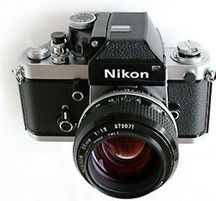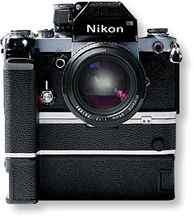Cont..
 |
This arrangement ensures very accurate exposure measurement even under adverse lighting situations. Since the metering is performed with the lens diaphragm fully open, the maximum aperture of a lens in use must be set into the meter. After mounting the lens, just turn the aperture ring counterclockwise, all the way to the minimum aperture setting, then clockwise as far as it will go. The aperture thus set will appear in the maximum aperture indicator window. |
Exposure data appear in the
viewfinder, below the view field. To the left and right of the meter needle are f-number
f/1.2 to f/32) and shutter speed (B to 1/2000 sec.) settings respectively.
The Photomic finder takes advantage of the automatic diaphragm feature of Nikkor
lenses to measure light with the lens wide open. Full-aperture metering gives a bright,
clear finder image for viewing and focusing and minimizes the effect of light entering
the viewfinder from the rear. The prism employed a pair of Cds metering cells
for exposure measurement which has an effective metering range of EV 1-17 at ASA
100 (1 sec. at f/1.4-1/2000 sec. at f/8 with 50mm f/1.4 lens); the film speed range
is from ASA 6-6400. It has a match needle display system and shown with the aperture
and shutter speed in use.
 |
The F2 Photomic viewfinder incorporates a thru-the-lens Centre-Weighted exposure metering system coupled with the shutter speed and aperture diaphragm for easy, accurate exposure reading even under difficult lighting conditions. The shutter speed and f-number in use appear in the viewfinder along with the meter needle and plus and minus marks to indicate over- or underexposure. |
In order to measure exposure at full aperture with lenses having different maximum apertures, the meter must be adjusted to the maximum aperture of the lens in use. This is done each time the lens is attached or changed as follows:
|
The film advance lever is used to switch on/off the Photomic meter, eliminating the need for a separate switch. It has a external meter window on top of the finder and provided with battery check. One of the drawbacks of this finder is, the meter reading tends to be very difficult to read in dim surrounding, you have to make use of an accessory (DL-1 Illuminator) to lit the finder.
 |
The original Nikon F2 Photomic (DP-1) was given a "rebirth" and extending its services when Nikon introduced their next generation of metering method with the AI feature; the resultant camera is called "Nikon F2A Photomic" which is actually a Nikon F2 Photomic with an updated AI feature incorporated. |
WARNING: Certain manual focus AI-S lenses such as Nikon Series E and ALL current version of AF Nikkor lenses WITHOUT the meter coupling Shoe (Rabbit EARs) on top of the aperture ring will not couple with the DP-1 Finder's exposure coupling BUT they can still be used in manual operation mode .
With proper setting of aperture
coupling, correct exposure is by centering the meter needle, with the plus and minus
marks indicating over-and underexposures respectively. The film advance lever functions
as an on/off switch for the exposure meter. It is switched on by pulling out the
lever to uncover a red dot on the top plate of the camera and switched off by pressing
the lever flush against the camera body. To check the condition of the silver oxide
batteries, press down the built-in battery checker while switching on the meter.
If the needle swings beyond the right edge of the notch, the batteries are in good
condition. The battery compartment is in the base plate of the F2 camera and accept
two silver oxide batteries (1.5V) for powering the exposure meter. Compared to the
conventional mercury battery, the silver oxide battery is more efficient in cold
weather, ensuring stable meter performance. Many countries prohibits the use of mercury
cells as it posts a danger of contamination and it thus not environmental friendly.
<<<< ---- The viewfinder eyepiece projects a 100% viewfield with 0.8X magnification which can also be considered "High Eyepoint" design with exposure data match needle display visible and also the viewfinder ready light atop the eyepiece.
Personal Conclusion: The Photomic DP-1 finder was the most popular finder among all other Prism models. Other than the moderately price it sold, It was also an extremely well made finder with reasonably good exposure range with its Cds cell from 2 sec to 1/2000 sec. The match needle design is either a hate or love relationship because it may require more accurate calibration which may prove too time consuming at times for certain photographic situation that may demand fast settings. It has not incorporated with the built-in eyepiece shutter yet and would also require a external accessory such as Photomic illuminator to power its finder when you often working in dim available light condition. It was the cheapest metered finder you can find among other more sophisticated metered finders produced by Nikon for F2 series. |
BEFORE skipping this page to next section, please be reminded the Instruction Manual for DP-1 Finder in HTML is also available in this site. Please don't mail me for any PDF version.
| Previous |
Next |
4/17 Other Nikon Metered Prisms DP-2,
DP-3 and AI finders
| Back |
Main Index Page - Interchangeable Viewfinders
System
Accessories:
Motor
Drives
/ Prisms / Screens / Macro / Film
Backs
/ Flash
Other Accessories:
DS-1 / DS-2 / DS-12 / eyepiece / DH-1 / cases / Cable releases / Miscellaneous
| History
& Background
| Semi-FAQ | Various Features and Functions - 6 Parts |
| Message Board | for
your favourite Nikon
F2 Series SLR model(s)
| Message Board | for your Nikon Optics in a shared environment
| Message Board | Specifically for Dispose or Looking for Nikon/Nikkor Photographic
Equipment
| Back | to Main Index Page of Nikon F2 Series SLR models
| Back |
Main Index Page of Pictorial History of Nikon SLRs
 |
The Eyes of Nikon:- |
Fisheye-Nikkor Lenses - Circular | Full Frame | Ultrawides Lenses - 13mm15mm18mm20mm | Wideangle Lenses - 24mm28mm35mm |
Standard Lenses - 45mm 50mm 58mm | Telephoto Lenses - 85mm105mm135mm180mm & 200mm |
Super-Telephoto Lenses - 300mm 400mm 500mm 600mm 800mm 1200mm |
Special Application lenses:
Micro-Nikkor Lenses - 50mm~55mm -60mm 85mm -105mm 200mm Micro-Zoom 70-180mm
Perspective Control (PC) - 28mm 35mm PC-Micro 85mm
Dedicated Lenses for Nikon F3AF: AF 80mm f/2.8 | AF 200mm f/3.5 EDIF
Depth of Field Control (DC): 105mm 135mm
Medical Nikkor: 120mm 200mm
Reflex-Nikkor Lenses - 500mm 1000mm 2000mm
Others: Noct Nikkor | OP-Nikkor | UV Nikkor 55mm 105mm | Focusing Units | Bellows-Nikkor 105mm 135mm
Nikon Series E Lenses: 28mm35mm50mm100mm135mm | E-Series Zoom lenses: 36~72mm75~150mm70~210mm
MF Zoom-Nikkor Lenses: 25~50mm | 28~45mm | 28~50mm | 28~85mm | 35~70mm | 36~72mm E | 35~85mm | 35~105mm | 35~135mm |
35~200mm | 43~86mm | 50~135mm | 50~300mm | 70~210mm E | 75~150mm E | 80~200mm | 85~250mm |
100~300mm | 180~600mm | 200~400mm | 200~600mm | 360~1200mm | 1200~1700mm
Tele-Converters: TC-1 | TC-2 | TC-200 | TC-201 | TC-300 | TC-301 | TC-14 | TC-14A | TC-14B | TC-14C | TC-14E | TC-16 | TC-16A | TC-20E
![]()
Nikon F
| Nikon F2 |
Nikon
F3
| Nikon F4 |
Nikon
F5
| Nikon F6 |
Nikkormat / Nikomat |
Nikon FM
| Nikon FE/ FA | Nikon EM/FG/FG20 | Nikon Digital SLRs | Nikon - Other models
MIR Supports for Photographic Community: Various Message Boards/Community
Forums
Nikon
F-series|
Nikon
F2-series|
Nikon
F3-series|
Nikon F4-series| Nikon
F5-series|Nikkormat/Nikomat-series
Nikon FM-series|Nikon
FE-series|Nikon
FA|Nikon
Digital
SLR
series|Various
Nikon
Models|Nikkor
Optic
-shared
Others:- Free Trade Zone - Photography| Free Trade Zone - Business Community |Free To Zouk - Photographic Community
Apple's Mac Public Community Message Board | Windows based PC &
Apple/Mac
Public Community Trade Exchange Centre
Recommended links to understand
more technical details related to the Nikkor F-mount and production Serial Number:
http://rick_oleson.tripod.com/index-153.html by: my friend, Rick Oleson
http://www.zi.ku.dk/personal/lhhansen/photo/fmount.htm by: Hansen, Lars Holst
http://www.mir.com.my/rb/photography/hardwares/nikonfmount/lens2.htm
http://www.photosynthesis.co.nz/nikon/serialno.html
About this photographic site.
HOME - Photography in Malaysia |
Copyright © 2000. leofoo ®. MIR Web Development Team.
In
memory of my friend Com.
Augusto Staut,
Brazil, 1971-2000.
Credit: Chuck Hester, US for his patience, encouragement
and help to setup the various content in this site; Robert Johnson for some of his original
images on the F2H-MD appeared in this site; my ex-staff, KiaSu for his superb
3-D logo appeared in this Nikon F2 site; Marc Vorgers from Holland who
generously provide me with some of his images of F2AS; MCLau®, who has so much time with me to
re-edit the content in this site and not to mention buying a Nikon Coolpix 990 just
for this site. Keat Photo,
Kuala Lumpur for providing
their Nikon F2A to take some images for this site; again, Mr Edward Ngoh the
great camera collector who provides us his collection of F2AS with MD-2; hawkeye.photographic.com
for their images on the Speed Magny film backs; Sean Cranor for his image
on Nikon F2 25th Anniversary Model; Ted Wengelaar®, Holland for his continuous
flow of input on some of the early Nikon bodies; CYLeow ® , photo editor of the Star
newspaper, Malaysia for some of his images used in this site. Ms Rissa Chan, Sales manager from
Shriro Malaysia who has helped to provide some of the very useful input. HiuraShinsaku®,
Nikomat ML, Japan for some of his images on various F2 models; my staff, Wati, Maisa, Mai and my nephew, EEWyn®, who volunteered and helping me
did so many of the film scanning works. Contributing photographers or resellers:
Jen Siow, Foo KokKin, Arthur Teng, Mark Fallander, John
Ishii, Ed Hassel, YoonKi Kim, Jean-Louis, M.Dugentas (Dell Corner.com.), Mr "Arsenall" and a few images mailed
in from surfers with no appropriate reference to their origin. Dedicated to KU Yeo, just to express our mutual regrets over the outcome of
a recent corporate event. Made with a PowerMac, broadcast with a Redhat Linux powered server.
![]()
![]()

